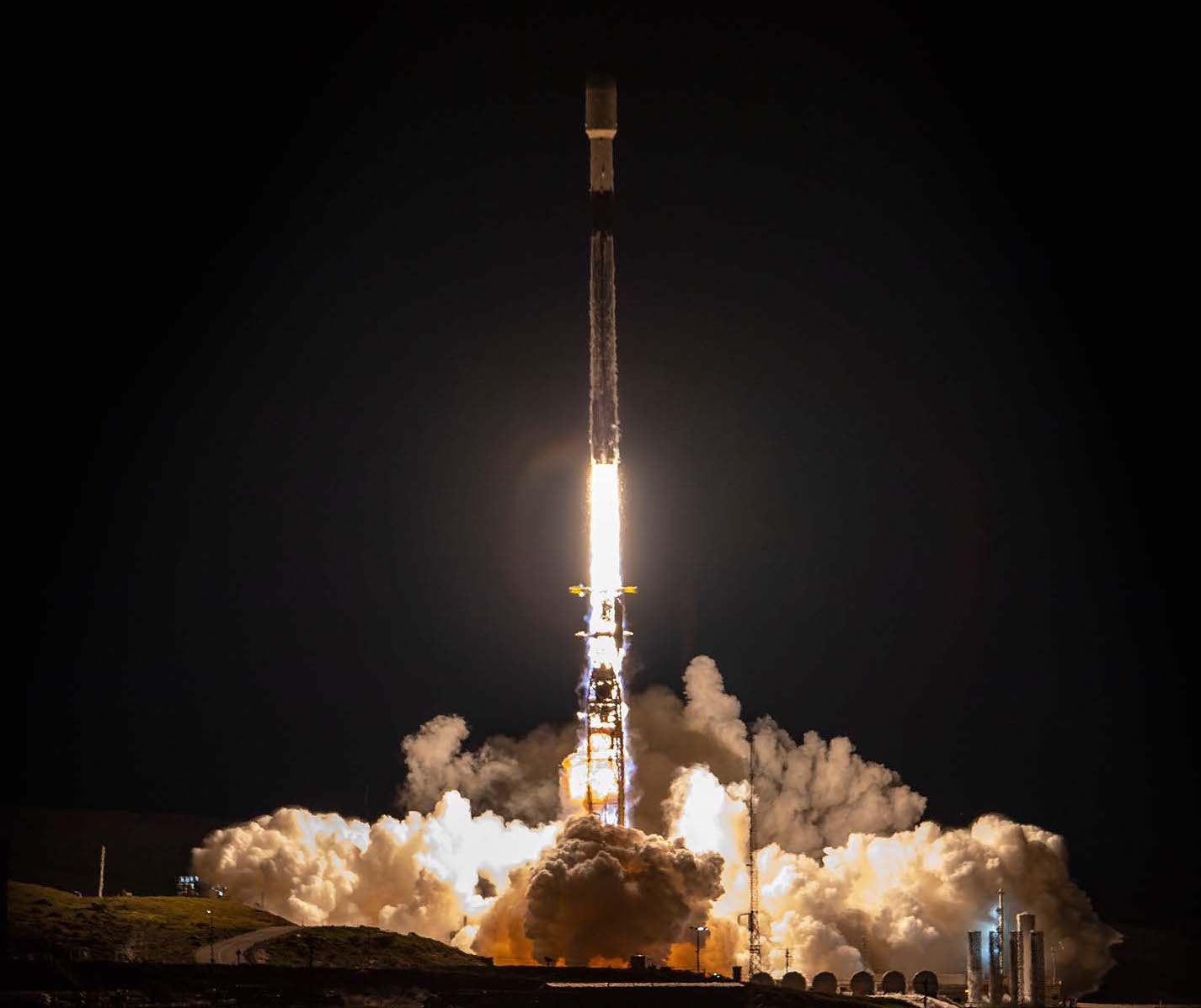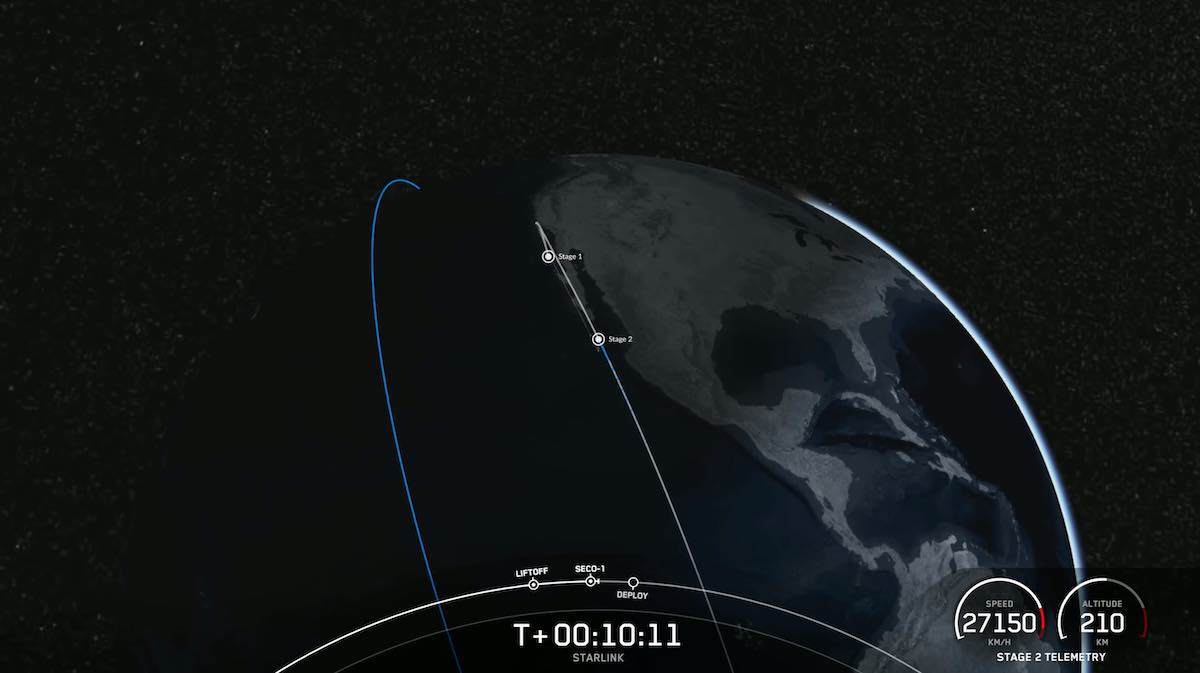
SpaceX deployed 52 more Starlink internet satellites into orbit early Saturday after a predawn launch from Vandenberg Space Force Base that routed a Falcon 9 rocket on an unusual track southeast from the West Coast spaceport over Baja California.
The 229-foot-tall (70-meter) launcher fired its nine Merlin 1D engines, throttled up to 1.7 million pounds of thrust, and climbed off Space Launch Complex 4-East at Vandenberg early Saturday, hauling the next batch of satellites to space for SpaceX’s global broadband network.
Liftoff occurred at 4:41:40 a.m. PST (7:41:40 a.m. EST; 1241:40 GMT), marking the seventh and final orbital launch attempt of the year from Vandenberg Space Force Base, and the 19th SpaceX mission overall from the launch facility on California’s picturesque Central Coast.
The Falcon 9 soared into a crystal clear sky free of fog and clouds that often obscure launch viewing at Vandenberg.
Two-and-a-half minutes after launch, the first stage’s nine engines shut down and the booster separated, beginning a descent back to SpaceX’s drone ship “Of Course I Still Love You” parked about 400 miles (650 kilometers) southeast of Vandenberg off the coast of Baja California.
The upper stage’s single Merlin engine ignited to accelerate into orbit, and slightly bent the rocket’s trajectory to the right in a “dogleg” maneuver to line up with the mission’s target orbital plane. The course took the Falcon 9’s upper stage and the 52 Starlink satellites over Baja California during the latter portion of the six-minute orbital insertion burn.
Meanwhile, the 15-story first stage nailed its landing on the football field-size recovery platform. The mission set a new record for the most-flown booster in SpaceX’s inventory, designated B1051, with its 11th launch and landing since debuting in March 2019.
Liftoff of SpaceX’s Falcon 9 rocket from Vandenberg Space Force Base with 52 more Starlink internet satellites. https://t.co/aHEzcbGNx9 pic.twitter.com/V52YtrX64S
— Spaceflight Now (@SpaceflightNow) December 18, 2021
The mission, named Starlink 4-4 on SpaceX’s launch schedule, targeted an elliptical, or egg-shaped, transfer orbit stretching 212 miles (341 kilometers) above Earth at its apogee, or highest point. SpaceX said the rocket reached its planned orbit before releasing the 52 flat-panel Starlink internet satellites about 15-and-a-half minutes after liftoff.
The deployment happened while the rocket was flying outside the range of ground tracking stations. SpaceX confirmed the successful payload separation when the Falcon 9 upper stage passed over an antenna in Chile.
The 52 satellites, each a little more than a quarter-ton, will use krypton-fueled ion thrusters to maneuver into their operating orbits at an altitude of 335 miles (540 kilometers), joining the rest of the Starlink fleet providing global internet service. With the newest batch of satellites, SpaceX has launched 1,944 Starlink spacecraft since May 2019.
A tabulation maintained by Jonathan McDowell, an astrophysicist and widely-respected tracker of spaceflight activity, showed that before the Starlink 4-4 mission, SpaceX had 1,729 functioning Starlink satellites in orbit. Of those, 1,467 satellites are operational, while the rest are still maneuvering into their slots in the constellation, or are otherwise working but not providing internet service.
SpaceX does not publish details about which of its Starlink satellites are operational, leaving outside experts like McDowell to gather and disseminate the information.
Jonathan Hofeller, SpaceX’s vice president of Starlink and commercial sales, said Tuesday that the Starlink network is providing internet service to consumers in more than 20 countries.
“We have well over 100,000 subscribers, both on the consumer and enterprise sides,” he said in a panel discussion at Euroconsult’s annual World Satellite Business Week event in Paris. “And we’re not slowing down. We’re just getting warmed up.”
SpaceX has a long-term plan to launch as many as 42,000 Starlink satellites, according to a company filing with the International Telecommunication Union. The company’s initial focus is on deploying around 4,400 satellites into five orbital “shells” at different inclinations.
The five Starlink orbital shells are all located between 335 and 348 miles (540 and 560 kilometers), at inclinations of 53, 53.2, 70, and 97.6 degrees. SpaceX completed launches into the 53-degree orbital shell in May, and started launching satellites into a 70-degree orbital shell from Vandenberg in September.
The launch Saturday was the third to target the 53.2-degree inclination shell, which flies nearly parallel with the 53-degree shell filled earlier this year. The previous two launches to 53.2 degrees took off from Cape Canaveral.
The next Starlink launch from Vandenberg was originally planned to go into a 70-degree orbital plane, but SpaceX grounded the mission in October without explanation. SpaceX launched a NASA asteroid probe from its pad at Vandenberg on Nov. 24. With the next opening in the company’s West Coast launch schedule available in mid-December, SpaceX switched the launch target to a 53.2-degree orbit.

Hofeller said SpaceX will begin launching more satellites into the polar orbital shell as soon as January. So far, SpaceX has launched a handful of Starlinks into polar orbit on rideshare missions, but hasn’t had any dedicated Starlink flights for the polar shell.
The Starlink satellites that started launching in the second half of this year all carry laser inter-satellite links, which also allow the network to pass internet traffic from spacecraft to spacecraft, without an intermediate step to relay the signals via a ground station.
“Our first-generation shell is in use and complete, and we’re launching our next-generation shell, which includes our inter-satellite links, as well as polar, in a month or so,” Hofeller said Tuesday.
“Currently, as we speak, we’re on cell phone towers, we’re on airplanes, we’re in schools, hospitals,” Hofeller said. “We’re across the board. There’s no lack of need for connectivity.”
The booster used Saturday morning is the most-flown booster in SpaceX’s fleet of reusable first stages. One other rocket has achieved 10 flights, and two have amassed nine launches and landings.
The payload fairing that shielded the 52 Starlink satellites during the first few minutes of flight through the atmosphere Saturday was also reused from previous missions. One half of the clamshell-like nose cone was on its fourth trip to space, and the other was flying a third time.
When SpaceX launched the first of its newest generation of Falcon 9 rockets, called the Block 5, in 2018, officials said the upgraded boosters could fly 10 times before requiring major refurbishment. But that has changed with flight experience.
Elon Musk, SpaceX’s founder and CEO, said earlier this year that there doesn’t seem to be “any obvious limit” to reusing Falcon 9 boosters. “We do intend to fly the Falcon 9 booster until we see some kind of a failure with the Starlink missions, obviously, just to have that be a life leader,” he said in April.
SpaceX has stretched the lifetime of its boosters by launching the company’s own Starlink satellites, which SpaceX builds in a factory in Redmond, Washington.
Since launching the first reused Falcon 9 first stage on a mission in 2017, SpaceX has cinched agreements with all of its customers to fly payloads on recycled rockets. Seventy-seven of SpaceX’s 135 Falcon 9 and Falcon Heavy flights have now used previously-flown boosters.
The launch Saturday from Vandenberg was the 29th Falcon 9 flight of the year for SpaceX, but the company isn’t done in 2021. Two more Falcon 9 launches are slated from launch pads in Florida on Saturday night and Tuesday morning.
If the next Falcon 9 takes off Saturday night, it will mark the first time two Falcon 9 rockets have flown on the same day.
Email the author.
Follow Stephen Clark on Twitter: @StephenClark1.
